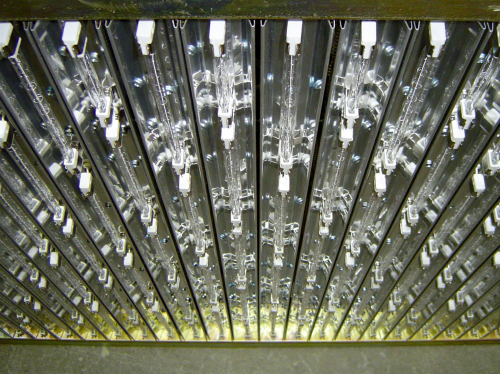
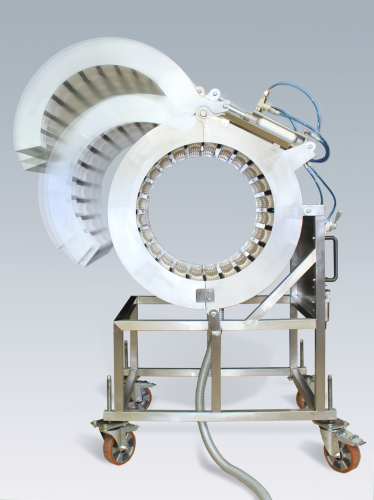
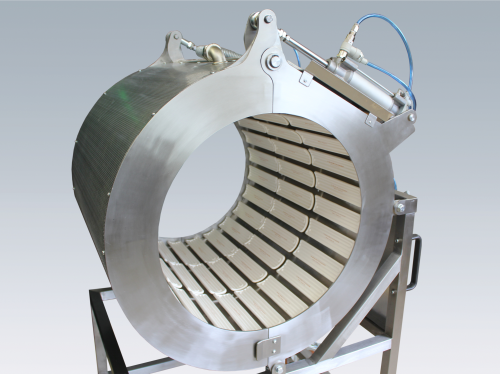
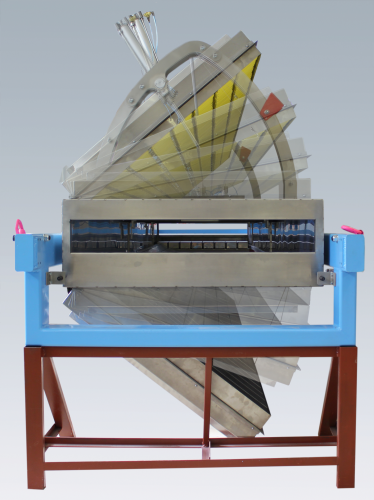
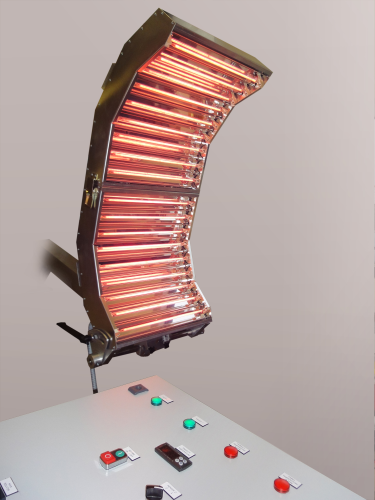
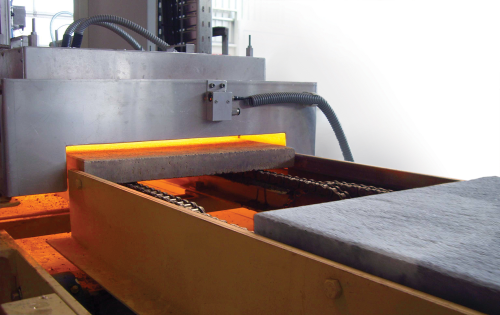
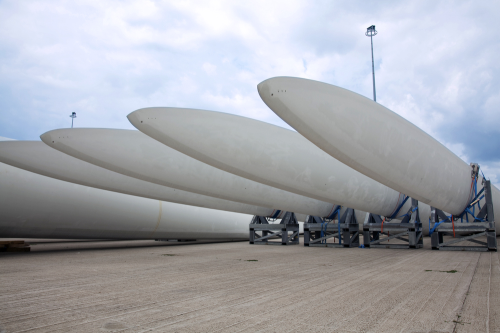
Advantages of IR heat in industry
Firstly, IR heating is mobile, rapid and flexible. It can be easily adapted to intermediate steps in the composites manufacturing or curing process, as well as deliver major savings in energy and curing time. In one study [P. Kiran Kumar 2011], IR curing resulted in a cure time of 56 minutes as opposed to 236 minutes for a normal ‘thermal cure’ in an oven. This is a saving of 75%. The study authors cited volumetric heating as a major factor in this fourfold increase, compared to a conventional heat which relied on thermal conduction through the epoxy and fibre matrix. A further advantage of IR is that being a radiative source it requires no medium. IR should not be thought of as heat but as an electromagnetic wave which behaves similar to light. Therefore it can pass through a vacuum. As the heating source is non-contact, contamination issues such as dust which may be a factor in convective heating are non-existent. Infrared heating in the majority of cases does not require onerous safety requirements. At very short wavelengths, the intensity of the light may require goggles or screening. When selecting an infrared emitter it is important to match the spectral absorption of the target material with the emitter. Many polymers absorb well in the mid to long wave regions. Although shortwave infrared heaters have the fastest heat up times, their high power density could lead to burning of the material surface. A lower power heater such as a ceramic or quartz heater may provide a more gentle heat thus allowing time for heat to penetrate the material to effect a thorough cure. The nature of the process also needs to be taken into account, whether it is a continuous or discrete process. Impurities such as dust or vapour also can hinder the absorption of infrared by the target material and provision may need to be made for its extraction or removal. The advantages of IR heating include:
- Fast heat up and fast cool down times (Infrared can be switched on where and when it is required)
- High watt densities possible (subject to material limits)
- Higher production speeds
- Compact installations
- Low investment cost
- Adaptable and expandable
- May be the only option in some repair cases
- Can penetrate into polymers giving a volumetric heating effect (as opposed to conductive and convective heating)
Applying IR heat in composite manufacturing
Radiant heat is of greatest benefit when used for the direct heating of a product. Infrared heating, for example, can be used in sheet forming of thermoplastic composites where a sheet of solid composite laminate is heated rapidly by infrared emitters and rapidly formed by pressing between two cooler tools which form the shaped mould. Such a process is associated with fast cycle times. For the three main types of heat curing resins used in composites (epoxy, phenol formaldehyde and urethane) infrared heating can offer a faster heating time, reduce the oven length, and increase line speed when compared with traditional convective heating ovens. Infrared also finds use in tape laying. In this process, a ‘tape’ of the raw material is heated and deposited on top of a previous one. A high watt density infrared lamp such as a quartz tube heats the area forward of the tape lay down. A precision robotically controlled head allows high repeatability and control. Several components on the Airbus A400M and A340 are produced in this way. The pre-heating of moulds can also be performed by IR heating. The surface of the mould may have to be treated in some cases to achieve a suitable reaction with the IR, resulting in fast surface heat up times. Repair operations on damaged composite structures, such as an aeroplane fuselage, is another area in which infrared technologies are displacing conventional heating mats and conductive methods. For irregular shaped components, infrared lamps can be designed which conform to the surface requiring the heat input. The repairs can be performed ‘in situ’ and the curing apparatus is light, mobile, and does not require contact with the surface being repaired. Infrared heating also has a role to play in the drying of fibres. In pultrusion, for example, the fibres must be completely dry before the resin comes in contact with the polyurethane as excess water can cause blistering on the surface of the finished profile. Even moderate humidity levels can cause problems with certain fibres and polymer combinations. Infrared heaters are an ideal method of treating the roving before pultrusion to flash off excess moisture. An intermediate stage in the processing of composites is de-bulking. In this process, the composite lay-up is carried out in stages before final curing. During these intermediates stages, vacuum and moderate heat can be applied to reduce problems such as wrinkling and void formation. Voids can cause interlaminar debonding by reduction the interlaminar shear strength, while regions of unsupported fibres can induce a local stress concentrations.
Putting it into practice
Many manufacturing sectors are increasingly realising that process heat issues need to be properly integrated into successful and cost effective projects from day one; even more so with matters of infrared energy. For example, Ceramicx is seeing an increasing amount of business involving heatwork guidance and undertaking a consultative role. This is principally regarding the understanding of various IR heat types and their effect on target composite materials, also IR heat control systems and the surrounding architecture to reach a production solution that works. This has included applications ranging from automotive to aviation, and from smart phone producers to white goods producers. Ceramicx believes that sections of the industry are at a tipping point that embraces process cost reduction - issues of energy and materials curing, as well as temperature, and IR heating could be a solution. IR heat work is not confined to new projects. Ceramicx has been involved in retrofitting heating plattens or oven mechanisms in older machines to enhance the heatwork and ensure that the energy being consumed is as much as necessary, but as little as possible.
The Ceramicx Centre for Infrared Innovation is launching a complete IR heat training syllabus for distributors, suppliers, customers, associates and industrialists. The initiative is a joint venture with the company's UK Comfort heat partners and associates Green Energy (EU). The online syllabus is now available. The vast majority is online learning but elements of classroom training can be undertaken. The training will cover:
|
See Infrared heating comes of age (Part 1)
This article was published in the March/April 2014 issue of Reinforced Plastics magazine.
The digital edition of Reinforced Plastics is distributed free of charge to readers who meet our qualifying criteria. You can apply to receive your free copy by completing this short registration form.






